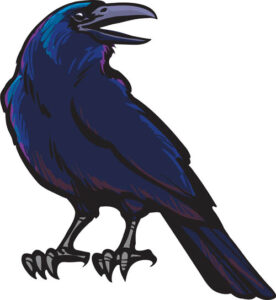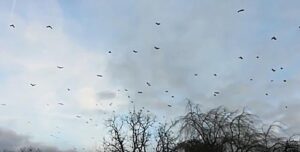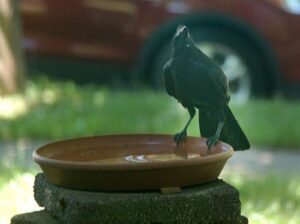Eating Crow
 I have a certain crow who visits my bird bath several times a day. Sometimes he drinks but usually comes with another purpose in mind.
I have a certain crow who visits my bird bath several times a day. Sometimes he drinks but usually comes with another purpose in mind.
Often he comes winging in carrying a piece of bread that he proceeds to soak in the water and then gulp down. Since we’re in the middle of the Brood-X cicada invasion, he will clear out any dead cicadas before dipping the bread in the water. I’m thinking he’s pretty smart to have figured out that bread (probably stale) is actually bad for birds and perhaps this makes it more palatable. Some people have the mistaken idea that birds like bread when in fact it’s bad for them.
 Bread is really,
Bread is really,
really bad for birds.
Basically, bread robs birds of the opportunity to take in the true nourishment their bodies require to survive.
Bread offers wild birds absolutely ZERO nutrition. ZERO. But, how could it possibly harm them, if it has zero effect? Simply, bread fills up a small stomach in a hurry. The bird doesn’t know the food is useless, but leaves feeling full and satisfied, nonetheless. This is a deadly combination, considering how many calories birds need to eat in order to survive.
To begin with, birds must be very efficient eaters due to rapid metabolism and the small size of their stomachs. Birds need to max out every meal in order to take in enough nourishment. Ideally, they should be filling up with food that has a high density of the proteins, fats, and carbohydrates they require. The food Nature intended. Bread is not that food.
Eating bread can turn deadly. With no calories to metabolize to stay warm, a small bird like a chickadee can freeze to death overnight with a stomach full of bread.
 Many people dislike crows and even fear them based on superstition. Even the term for a group of crows is “a murder of crows” and they are often associated with death or as an omen of bad things to come. In parts of Appalachia, a low-flying group of crows means that illness is on the way.
Many people dislike crows and even fear them based on superstition. Even the term for a group of crows is “a murder of crows” and they are often associated with death or as an omen of bad things to come. In parts of Appalachia, a low-flying group of crows means that illness is on the way.
 The reality is that crows and their corvid cousin, the raven, are extremely intelligent, capable of solving complex puzzles, and making multipart tools. Recent research even shows that they know what they know and can ponder the content of their own minds, a manifestation of higher intelligence and analytical thought.
The reality is that crows and their corvid cousin, the raven, are extremely intelligent, capable of solving complex puzzles, and making multipart tools. Recent research even shows that they know what they know and can ponder the content of their own minds, a manifestation of higher intelligence and analytical thought.
Click here to watch this BBC video of a crow name 007 who solves a complex, 8-step puzzle to get a food reward.
8 ways crows are smarter
than you think!
- They are as smart as a 7-year-old child While a crow’s brain may seem small in comparison to a human, what matters is the size of the brain in relation to the size of the animal. Relative to their bodies, crow and primate brains are comparable.
- They recognize human faces. A team of researchers captured crows, tagged them, and released them. Members of the team wore different masks. Crows would dive-bomb and scold people wearing a mask, but only if the mask had been worn by someone who had messed with them.
- They talk about you to other crows. If you think two crows watching you and cawing at each other are talking about you, you’re probably right. The intensity, rhythm, and duration of caws seems to form the basis of a possible language.
 The have very good memories. An interesting case of crow memory comes from Chatham, Ontario. Around half a million crows would stop in Chatham on their migration route, posing a threat to the farming community’s crops. The mayor of the town declared war on crows and the hunt began. Since then, the crows have bypassed Chatham, flying high enough to avoid being shot. This has not, however, stopped them from leaving droppings all over the municipality.
The have very good memories. An interesting case of crow memory comes from Chatham, Ontario. Around half a million crows would stop in Chatham on their migration route, posing a threat to the farming community’s crops. The mayor of the town declared war on crows and the hunt began. Since then, the crows have bypassed Chatham, flying high enough to avoid being shot. This has not, however, stopped them from leaving droppings all over the municipality.- They use tools and solve problems. While several species use tools, crows are the only non-primates that make new tools. In addition to using sticks as spears and hooks, crows will bend wire to make tools, even if they have never encountered wire before. In Aesop’s fable of “The Crow and the Pitcher,” a thirsty crow drops stones into a water pitcher to raise the water level to take a drink. Scientists tested whether crows really are this smart. They placed a floating treat in a deep tube. The crows in the test dropped dense objects into the water until the treat floated within reach. They didn’t select objects that would float in the water, nor did they select ones that were too large for the container.
- Crows plan for the future. Crows not only plan for future events but consider the thinking of other crows. When a crow caches food, it looks around to see if it’s being observed. If it sees another animal is watching, the crow will pretend to hide its treasure, but will really stash it in its feathers. The crow then flies away to find a new secret spot.
- They adapt to new situations. Crows have adapted to life in a human-dominated world. They watch what we do and learn from us. Crows have been seen to drop nuts in traffic lanes, so the cars will crack them open. They will even watch traffic lights, only retrieving the nut when the crosswalk sign is lit. This in itself probably makes the crow smarter than most pedestrians. Crows have been known to memorize restaurant schedules and garbage days to take advantage of prime scavenging times.
 Crows understand analogies. (A Moscow-based team trained crows to match items that were the same as each other (same color, same shape, or same number). Next, the birds were tested to see if they could match objects that had the same relationship to each other. For example, a circle and a square would be analogous to red and green rather than to two oranges. The crows grasped the concept the first time, without any training in the concepts of “same and different.”
Crows understand analogies. (A Moscow-based team trained crows to match items that were the same as each other (same color, same shape, or same number). Next, the birds were tested to see if they could match objects that had the same relationship to each other. For example, a circle and a square would be analogous to red and green rather than to two oranges. The crows grasped the concept the first time, without any training in the concepts of “same and different.”
My crow visitor has demonstrated his intelligence by solving the problem of eating stale bread. Marinate it! Downside? He is a very messy eater so I’m cleaning the birdbath a lot more.
References: Backyard Naturalist and ThoughtCo.com
Ross A. Feldner, RCC Board Member
 Ross Feldner is the lead, with Bob Musil, of the RCC Bird Watch and Wonder Program. Ross is a life-long birder and photographer who is the editor of the Friends of Patuxent National Wildlife Refuge newsletter. Ross also serves as a guide at the Patuxent National Wildlife Refuge, a frequent birding spot for Rachel Carson who first learned about the health effects of DDT at the laboratory there. He is also the owner/art director of New Age Graphics, a full-service graphic design firm in Wheaton, MD.
Ross Feldner is the lead, with Bob Musil, of the RCC Bird Watch and Wonder Program. Ross is a life-long birder and photographer who is the editor of the Friends of Patuxent National Wildlife Refuge newsletter. Ross also serves as a guide at the Patuxent National Wildlife Refuge, a frequent birding spot for Rachel Carson who first learned about the health effects of DDT at the laboratory there. He is also the owner/art director of New Age Graphics, a full-service graphic design firm in Wheaton, MD.
![]() The Rachel Carson Council depends on tax-deductible gifts from concerned individuals like you. Please help if you can.
The Rachel Carson Council depends on tax-deductible gifts from concerned individuals like you. Please help if you can.
![]() Sign up here to receive the RCC E-News and other RCC newsletters, information and alerts.
Sign up here to receive the RCC E-News and other RCC newsletters, information and alerts.